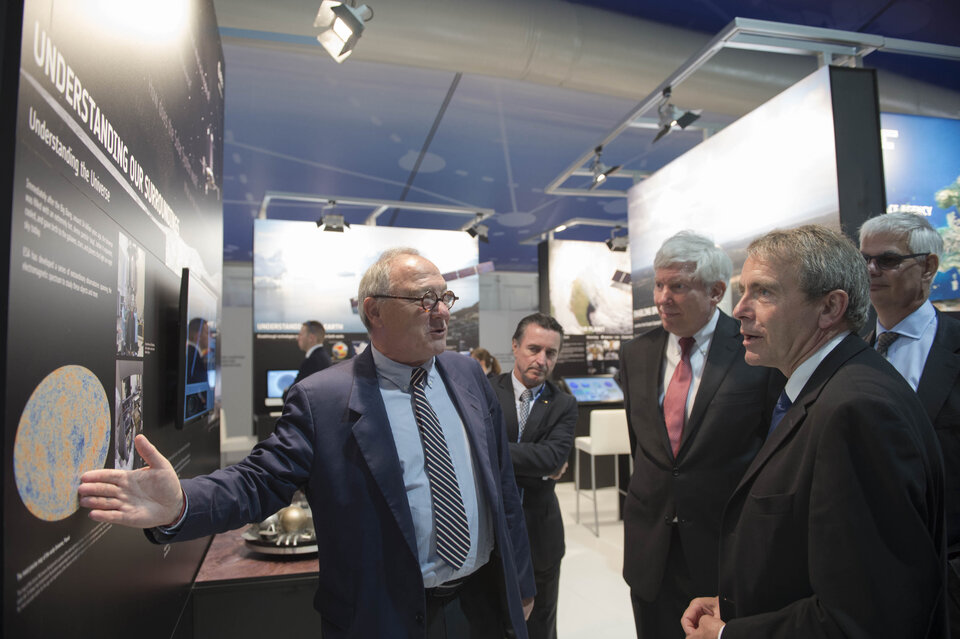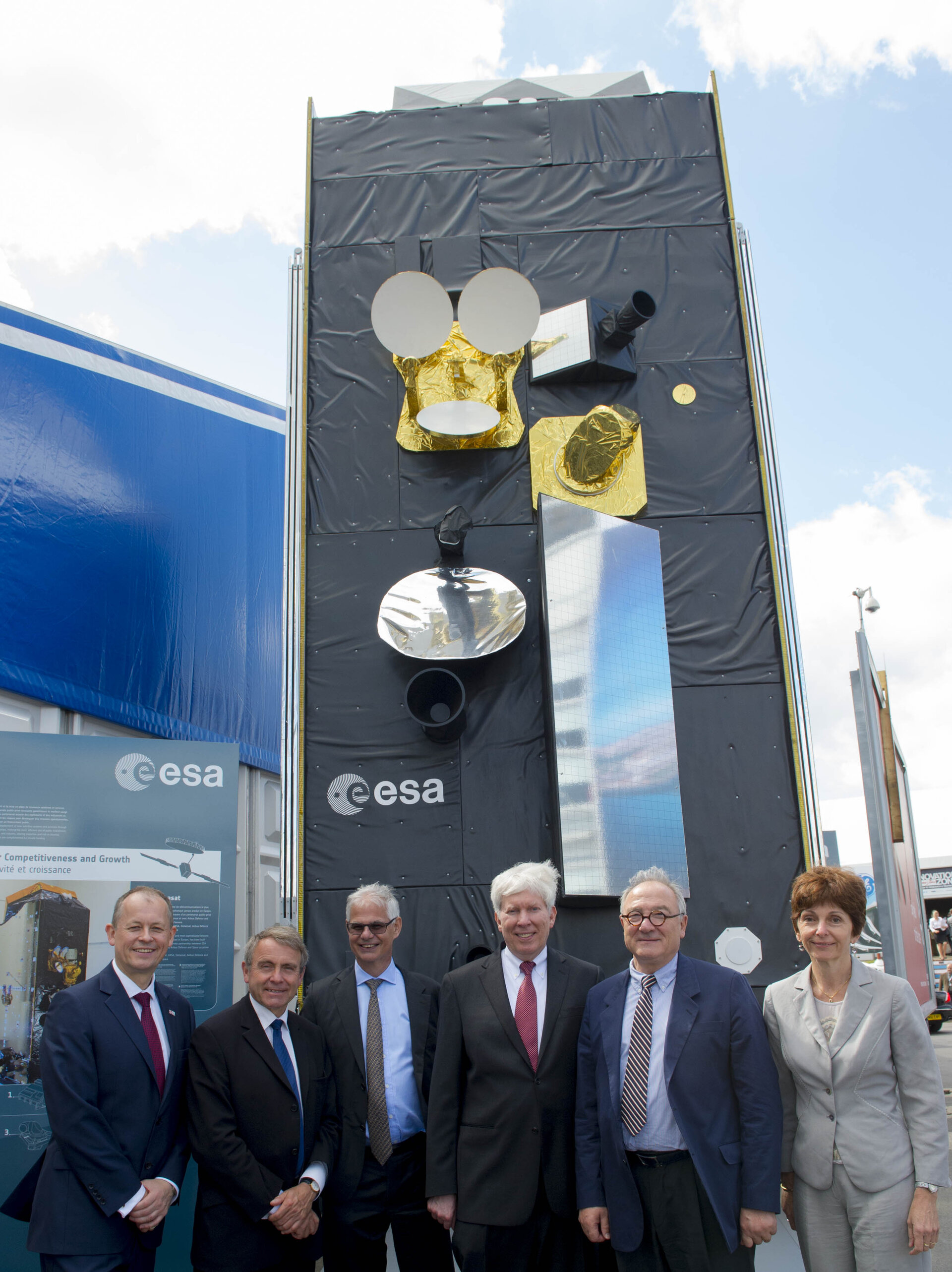ESA at Farnborough air and space show
Visitors to the major Farnborough International Airshow will be able to enjoy ESA’s exhibition highlighting its achievements and plans in a dedicated Space Zone all next week.
One of the world’s largest aerospace trade shows, Farnborough brings together key players from the international aerospace community, industry, space agencies and trade visitors interested in discovering the latest developments and business opportunities.
Main exhibitors in the Space Zone of Hall 3 this year include ESA, Russia’s Roscosmos, the UK Space Agency, Airbus Defence & Space, Qinetiq and Surrey Satellite Technology Ltd.
Throughout the week, the zone will host presentations and events, and a dedicated Space Day conference will be held in the Media Centre on Tuesday, 15 July.
The airshow is open to trade visitors Monday–Thursday, 14–17 July, to students on Friday, 18 July and to the general public on Saturday–Sunday, 19–20 July.
This year, when the agency and its member states are celebrating 50 years of European cooperation in space, ESA’s exhibition underlines the importance of building on past achievements in space science, exploration and applications to shape the future of Europe in this strategic sector.
The exhibition reflects the wealth of recent mission results and upcoming launches across all space domains. It also highlights ESA’s new centre in the UK: ECSAT, the European Centre for Space Applications and Telecommunications, which focuses on telecommunications, integrated applications, climate change, technology and science.
ECSAT is particularly interested in developing commercial space-based products and services, downstream applications and the ‘spin-out’ of space into non-space sectors. Experts will be on hand to demonstrate these activities. The programme of presentations and workshops is available here.
http://www.ukspace.org/event/farnborough-international-air-show/
“Investing in space is investing in competitiveness and growth through knowledge, innovation and services,” notes Jean-Jacques Dordain, ESA’s Director General. ESA’s exhibition reflects these key principles.
Competitiveness and growth

A full-size model of Alphasat, the largest and most sophisticated telecom satellite ever built in Europe, greets visitors in front of the Space Zone. Alphasat and its Alphabus platform are excellent examples of innovative public–private partnerships.
ESA helps to develop satellite systems and technologies, opening up new markets for European industry by sharing expertise and risk in order to build operational missions.
Creating new technology lies at the heart of ESA activities, helping European industry to compete worldwide. At Farnborough, ESA is displaying some of the innovative and cross-cutting technologies flying on its Proba satellites, and will host daily demonstrations of space technologies and systems spun out from ESA’s Business Incubation Centres.
In addition, ESA will present Ariane 5, Soyuz and Vega, the family of launchers operated from Europe’s Spaceport in French Guiana, offering a complete range of services and capabilities from the best launch site in the world today.
Space-based services
Visitors to the pavilion can learn more about space-based services provided to aviation by EGNOS, the European Geostationary Navigation Overlay Service, operational since March 2011, and about the Galileo satnav constellation, with two further satellites to be launched in the coming weeks.
ESA is developing a wide range of telecom services and applications to provide space-based services efficiently and seamlessly over almost every region of our planet in fields such as air traffic management and maritime surveillance.
Presentations and demos throughout the week include the Iris project – creating an air-to-ground communication system for managing air traffic – and applications and services being developed under ESA contract for aviation, telemedicine, maritime safety, media streaming and geophysical surveys.
ESA has long worked in close cooperation with Eumetsat to improve weather forecasts and climate studies with the Meteosat and MetOp series. Information pouring in from space from these satellites is displayed alongside examples of maps for disaster management authorities, produced under the International Charter on Space and Major Disasters, co-founded by ESA in 2000 with many other space agencies around the world.
Impressive images are displayed from the first of the Sentinel satellites, launched on 3 April under the ambitious EU Copernicus initiative. This will provide access to precise and timely information for managing the environment, understanding and mitigating the effects of climate change, and ensuring civil security.
Pushing back the boundaries of knowledge
The exhibition highlights how breakthroughs in technology and science have brought us greater knowledge of the Universe, of our planet and its unique place in the Solar System.
Because of its physical similarities with Earth, Mars is a primary target for the search for life. A simulated Mars terrain features scale models of the three elements of ExoMars, ESA’s next mission to the Red Planet, in close cooperation with the Russian space agency.
A special audiovisual display presents ESA’s ambitious Rosetta mission as it attempts to rendezvous with a comet and set a lander on its surface later this year, to help understand if these mysterious objects brought life to Earth.
The latest results of the Planck mission are displayed, showing the most detailed map ever created of the ancient radiation from the Big Bang.
Earth Explorer satellites are addressing the most urgent questions facing our planet: CryoSat is measuring the volume of land and sea ice, GOCE studied Earth’s gravity, SMOS is surveying ocean salinity and soil moisture, and the Swarm constellation is carrying out an unprecedented study of Earth’s magnetic field.
ESA are highlighting the cutting-edge space technology developed in Europe now flying on the International Space Station, and scientific results from experiments carried out in Columbus and other laboratories.
ESA astronaut Alexander Gerst is currently on the Station, and Samantha Cristoforetti and Tim Peake will fly to the orbital outpost in the next 12 months for long missions, reinforcing the importance of Europe’s role in this unique international partnership.
The fifth and final Automated Transfer Vehicle supply vessel, to be launched later this month, is featured together with a model of the European Service Module that will rely on ATV technology to power NASA’s Orion spacecraft for carrying astronauts beyond low-Earth orbit.




